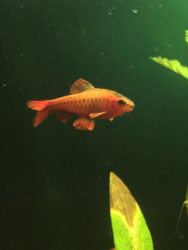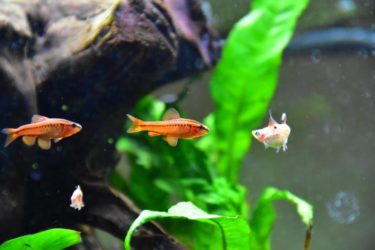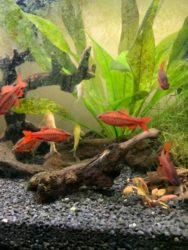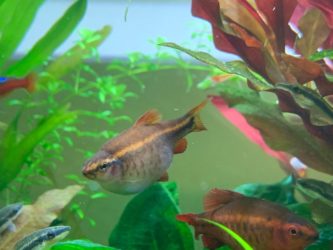Table of Contents
Cherry Barb: A Quick Summary
Cherry barbs are small, colorful freshwater fish native to Sri Lanka. They are popular among aquarists for their bright red and orange coloration and peaceful nature. They prefer to live in groups and do well in well-planted tanks with plenty of hiding spots.
Cherry Barb Overview
Cherry Barb is one of the most popular barb fish species that is well adapted to live in freshwater. It is a good choice for beginning aquarists because it is so easy to care for and will also tolerate a wide range of water conditions. It is a peaceful fish thus making it well suited for the community tanks as this makes it cope well with other types of fish within the same tank. Cherry Barb is actually small in size and will only grow to a maximum size of 1.5 to 2 inches long. It is best to keep the fish in schools of at least 6 or more in the same tank.
The fish is known to be somewhat choosy when it comes to the food that it eats especially when it is still being acclimated to the tank. The good news however is that after some time you will soon see the fish getting used to the fish foods that you will be proving them. Even though the fish are highly tolerant to a diverse range of changing water parameters proper care should be administered to them just as you would do with other delicate fish species.
Cherry Barb Habitat in the wild
It is a freshwater fish that is native to the Asian island nation of Sri Lanka particularly the south west areas of Kelani and Nilwala river valleys. The fish typically inhabit ponds characterized by shadowed surroundings. In the streams and small rivers, the fish prefer to inhabit the muddy bottom sections. The prefer dwelling in the muddy bottom because there, they easily feed on the many plant matter growing there. In the wild areas where these fish inhabit, the sun’s rays rarely reach the bottom of the river. The temperatures in the rivers or ponds usually vary between 23°C and 27°C.

In ponds that the fish inhabits, the bottom part is usually sandy and there are lots of plant leaves as well as sunken tree branches. Due to the dwindling numbers of the fish in the wild, the Sri Lankan government enforces a law prohibiting the export of the fish out of the country but illegal harvesting still occurs. Interestingly, even though in the wild the fish is almost going extinct, those being reared by hobbyist are still flourishing. Because many people prefer the brightly colored cherry barb, they are one of the most captured in the wild thus their numbers have greatly dwindled to alarming low levels.
Appearance of the Cherry Barb
Cherry barb is a relatively small sized fish that may grow to its maximum extent of just 2 inches long in length. The body is elongated with a curved like backside and its lateral line appears somewhat incomplete. It features a pair of barbs with a mouth that looks inferior. There are striking differences of the males and the females of the fish. The males have backs that are brown to green with either a reddish bottom part of the body. The lateral line in the males appears brown-red. The female of the fish have an abdomen that is whitish with a yellow-grey back. The lateral line of the female barb is also just the same as that of the male which is brown-red. The fins of both the male and female show characteristic yellowish – red color.
Cherry Barb Care and Tank Requirements
It is one of the most easy to care for fish in the aquarium hobby thanks to its high level of tolerance of varying water parameters. It is a small sized fish that is best reared in groups or schools of at least six fish per tank. Because in the wild, the fish likes to live in groupings, it is best to replicate this in the tank to reduce the possibility of stress. To get the best tips for care and tank requirements for the fish please read below:
The recommended tank capacity for keeping 6-10 barbs should be between 50 to 100 liters roughly 13-25 gallons of water. The tank should be heavily planted to provide enough hiding places for the fish because they can be very timid sometimes. Also ensure that there is enough free space in the tank for the fish to roam about.

Ensure that the water in the tank is perfectly filtered with a solid aquarium filter and the water motion or circulation there should be slow. You can house it together with only other peaceful fish. You could use aquarium sand as the substrate in your tank as this will replicate its wild habitat.
- The ideal tank temperature should be 73°C to 81°C
- The water pH should be between 6 and 8
Feeding Cherry Barb
It is an omnivorous fish that is it eats plant matter as well as meat. It is easy to feed because it eats a wide variety of food. Due to its rather small size it finds it hard to swallow big chunks of foods and therefore you may need to crush grains or meat before giving it to eat.
Among some foods that you offer the fish includes:
- Frozen brine shrimp
- Spirulina
- Frozen dried blood worms
- Micro wafers for fish
- Fish flakes
The difference in the sexes
When the fish is still young it is difficult to differentiate the male from the female. When the fish grow and develop reaching maturity, the differences suddenly become apparent. You will the female fish having a larger body with an abdomen that is rounded. The male of the fish is usually slim and usually more colored than the female.
Breeding Cherry Barb
Breeding Cherry barb requires some levels of expertise as the tank requirements for conditioning spawning is usually special. The spawning tank should have water capacity of 20-25 cm. The temperature range for the spawning tank should be set to 26 – 28°C. When it is time for spawning it is best to place the males and females at a ratio of 2:1. Basically after spawning has successfully been achieved, the eggs should not be exposed to bright light. The males and the females also need to be removed from the tank. Effectively after fertilization of the female eggs, it will take 2-3 days for them to hatch into juvenile barbs.

FAQs
How Many Cherry Barbs Should Be Kept Together?
Since Cherry Barbs are schooling fishes, it is fine to maintain them in groups of five numbers each. However, there is a hierarchy that is required to be maintained in these schools of fish. The ratio of male: female is required to be 2:1. The cherry barb fishes are habitually less separate than those of other barbs.
How Do You Take Care Of Cherry Barbs?
Cherry Barbs are shyer fishes. The home aquarium where they stay has to be maintained well. If the maintenance of the aquarium cleanliness is regularized, caring for the cherry barbs becomes easier. When the tanks are filled with plants, the dead plants must be removed at regular intervals. The pH levels in the water have to be maintained to ensure the acidity of the water is under control.
Is Cherry Barb Hardy?
Cherry Barbs are robust. They prefer to stay in the manner of schooling. They are bright-colored fishes. Among all the members of their family, Cherry Barbs are considered the most important species. These characteristics of the Cherry Barbs make them very adorable.
These species of Cherry Barbs are hardy fishes, making them a perfect choice for either experts or beginners. They’re highly strong and long-lasting species and resistant to diseases. As a result, they’re reflected as hardy fish and aren’t affected by the illness, which is species-specific.
How Much Water Do Cherry Barbs Need?
The average size of the tank required for Cherry Barbs should be a minimum of 25 to 30 gallons. This volume of space in a single tank shall allow a school of fish to be fitted in the tank without being felt overcrowded. The tank should be big enough to accommodate 50 to 100 liters of water so it can easily and safely fit in 6-10 cherry barbs. It should be ensured that there is sufficient free space in the tank which facilitates the cherry barbs to roam around.

Do Cherry Barbs Like Flow?
Cherry Barbs like streams and gullies with rich vegetation. They prefer well-shaded surroundings. When the water is shallow, rich with silt nourishment, and continues to flow slowly, it makes the cherry barbs comfortable in their habitat. Cherry Barbs are not exceedingly delicate fishes. They also respond to minimal variation well. The conditions of their habitat are required to be kept stable with a moderate flow of water.
What Temperature Do Cherry Barbs Like?
The natural habitat for Cherry Barbs is shallow and calm water rich in silt nourishment and leaf cover. The pH of the water should be maintained between 6 to 8. The hardness of water (dH) should be f 5 to 19. The temperature should range from 73 °F to 81 °F (23 °C to 27 °C). When these basics are made available to the Cherry Barbs, the need for more requirements shall not arise.
The parameters of the water should be kept consistent. These fishes can feel stressed and also develop sickness if there are temperature fluctuations. Also, changes in the levels of silt nourishment can add stress to these fishes. The fluctuations in salinity or acidity levels also contribute to increasing stress among these species. The temperature must be staying at the levels of 73 °F to 81 °F at all times.
Are Cherry Barbs Good With Bettas?
Holistically, the cherry barbs go well along with the betta fishes. There are a few basic requirements to make the cherry barbs and betta fishes partnership work. A lonely betta fish can gain company from a small group of cherry barbs and go well with them.
The water conditions required for both the fishes are the same. These fishes can survive in small tanks. It is required that their habitat fulfills basic lighting necessities. Both these breeds of fish consume a similar diet.
It is best to initially construct the community tank to ensure that the betta fish does not attack the cherry barbs. Then, the betta fishes slowly understand their newcomers and shall not consider them as competitors.
How Fast Do Cherry Barbs Grow?
In about two months, the cherry barbs grow into the size of an adult. When the cherry barbs are fully grown, their maximum size is about 2 inches in length. However, depending on the care given to the baby cherry barbs and genetic factors, there are possibilities for the cherry barbs to stop growing at 1 inch.
When the basic parameters of the tank are met, it facilitates the growth of the Cherry Barbs. These basic parameters include pH, hardness levels, temperature, space available, and available feeding options. With these parameters, the Cherry Barbs can grow up to a quarter to half an inch every six weeks.
Can Angelfish Be Kept With Cherry Barbs?
Yes, angelfish can be kept with cherry barbs. However, there are a few instances which had caused stress to angelfishes. Most of the regular barbs nip the fins of the angelfishes. Since angelfish are long-finned fish, it becomes easy for the barbs to nip their fins. Cherry Barbs are not that destructive.
Cherry barbs can live with angelfish. However, it is recommended to keep them in a school along with other fish. Watching how they behave is required to move them to separate tanks if they don’t get along well. Cherry Barbs and Angelfish are highly well-matched. The water parameter requirements for both Cherry Barbs and Angelfish are similar. The ideal pH levels in water for Angelfish should be within the 6.5-8 range, close to the ideal pH levels for Cherry Barbs 6-8 range.
Why Are Cherry Barbs One Of The Most Popular Aquarium Fish?
Cherry Barbs are in bright patterns. It is easy to manage the Cherry Barbs as maintenance is very minimal. As Cherry Barbs loves to stay in groups, it becomes so much fun taking care of them. Also, Cherry Barbs are less aggressive and maintain peaceful behavior. Purchasing the cherry barb is a great choice. Many reasons make Cherry Barbs a good choice as a freshwater aquarium fish.
Individuals starting the hobby of fishkeeping can start with Cherry Barbs as they make the best beginner fish. They are friendlier fishes and ideal for a community tank. However, they require the tanks to be planted or filled with plant debris.
Generally, Cherry Barbs live for three to five years. However, with extra care, attention, the right habitat, water parameters, and other tank mates being provided, the Cherry Barbs can live up to seven to eight years.
Cherry Barbs go well with Tetras, Rasboras, Gouramis, Assassin snails, and small catfish like Otocinclus catfish. However, it is recommended to avoid aggressive fish species to be kept with cherry barbs.
What Are The Common Cherry Barbs Health Issues And Treatments?
Cherry Barbs should be looked after well to avoid any health issues. The health issues can change the behavior of the fish. Changes in behaviors can include fishes being lethargic, not eating the nourishment as required, or rubbing their body on the walls of the tank.

White spot disease is the most common visible health issue among the fishes. This is also called Ich. When water is treated with Ich medication, it treats the White spot disease. Other instances of illness which can be caused among the fishes include velvet disease, fin rot, and dropsy. Therefore, regular treatment is required to manage the health issues.
Since Cherry Barbs provides hours of comforting pleasure to keep looking at them swimming together, it is essential to take proper care of them. Fish can spread the diseases to other tank mates. Hence healthy maintenance of the fish enables the popular freshwater fish to continue being the best beginner fish.
No related posts.

1 thought on “Cherry Barb: Care Guide, Breeding, Tank Size and Disease”
73 degrees C lol nice typo